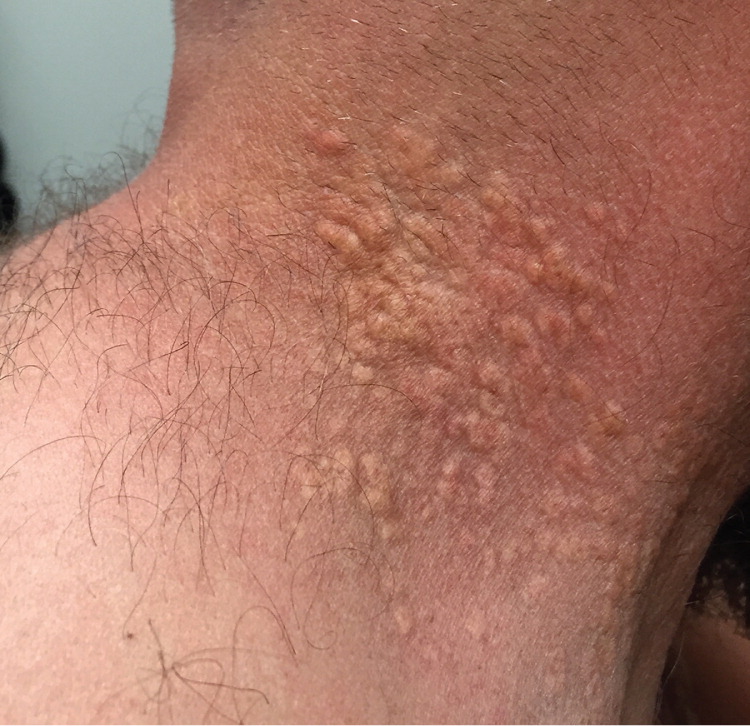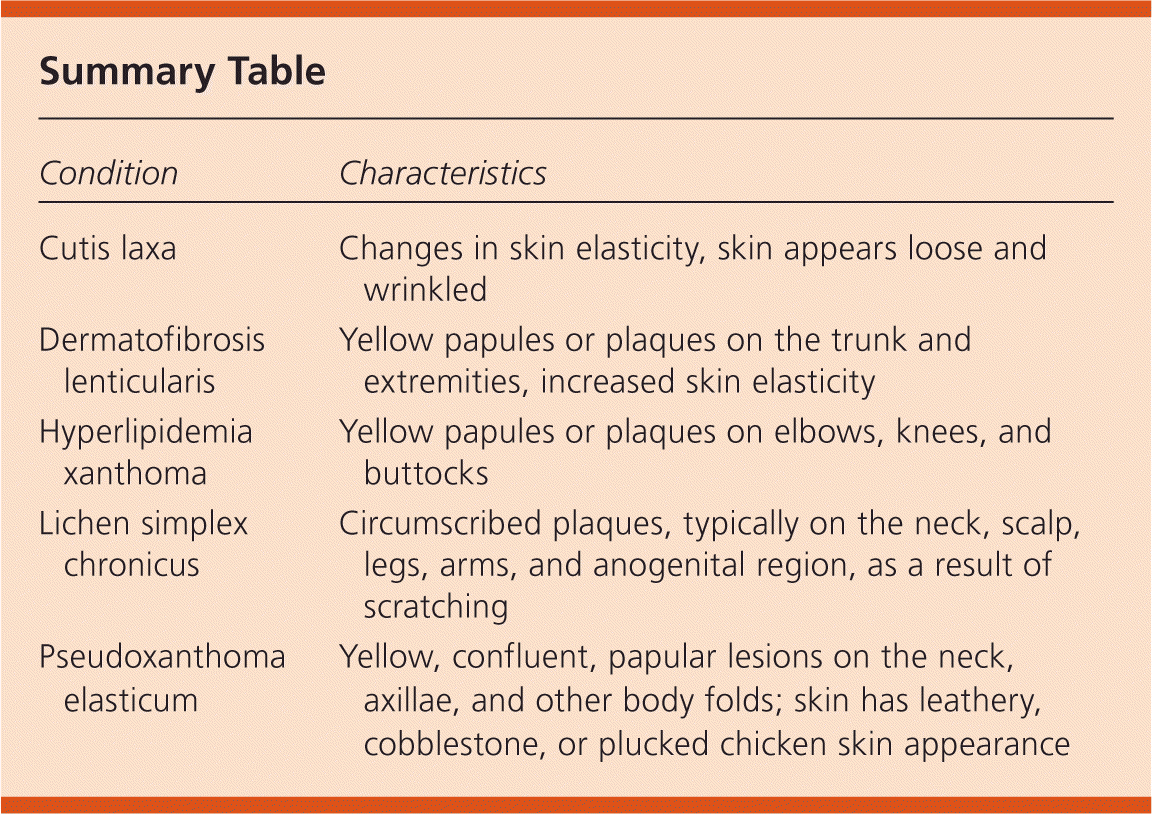
Am Fam Physician. 2016;94(11):921-922
Author disclosure: No relevant financial affiliations.
A 39-year-old man presented with bilateral blurry vision that began suddenly three days prior. He did not have any recent eye injuries, irritation, pain, or drainage. He had no other symptoms.
Physical examination revealed normal conjunctiva and sclera without erythema, discharge, or foreign body; the pupils were normal. Funduscopy showed abnormal streaks in a spoke-like pattern extending from the optic disc. Confluent, yellow papules and plaques were observed on the lateral aspects of the neck (Figure 1). The skin changes had developed during middle school, and the patient attributed it to a birthmark. The lesions were not painful or pruritic.

Question
Discussion
The answer is E: pseudoxanthoma elasticum. This autosomal recessive connective tissue disorder leads to the calcification of the elastic tissues in the skin, eyes, and vasculature. Characteristic skin manifestations include yellow, confluent, papular skin lesions that occur on the neck, axillae, and other body folds.1 The lesions have been described as leathery, or like cobblestones or plucked chicken skin.2 Calcification can contribute to a loss of skin elasticity. Skin changes are subtle and commonly overlooked by the patient. Ocular manifestations of pseudoxanthoma elasticum appear between 20 and 40 years of age and include angioid streaks and retinal epithelial mottling, with progression to vision loss late in the disease course.
Vascular changes are the most serious and life-threatening complications of pseudoxanthoma elasticum. These complications are a result of abnormal collagen, deposition of calcium, and loss of elasticity of the blood vessels. Patients are at increased risk of gastrointestinal hemorrhage, claudication, cerebrovascular accidents, angina, and myocardial infarction. Biopsy of the skin lesions is diagnostic. Vascular changes may also be noted on extremity radiography and arteriography studies. If pseudoxanthoma elasticum is suspected, evaluation for vascular complications and internal bleeding is recommended, including ophthalmology and cardiology evaluations. There is no cure, but management of blood pressure and cholesterol may reduce cardiac risk. Genetic counseling is suggested because of the genetic nature of disease.1
Cutis laxa is associated with several genetic and acquired disorders that result in changes of skin elasticity. The skin appears loose, wrinkled, or hanging off the body. Cutis laxa is a common finding in patients with pseudoxanthoma elasticum. There is no treatment for the loss of skin elasticity, but cosmetic surgery is an option for some patients.1
Dermatofibrosis lenticularis disseminata is an autosomal dominant disorder that is an association between osteopoikilosis and connective tissue nevi. It presents as yellow papules or plaques on the trunk and extremities, and increased skin elasticity. Musculoskeletal limitations are the most common symptom associated with dermatofibrosis lenticularis; however, ocular and gastrointestinal symptoms have also been reported.1
Dermatologic manifestations of familial and acquired hyperlipidemia include xanthomas that are deposits of lipids in the skin and subcutaneous tissue. Hyperlipidemia most commonly results in eruptive xanthomas, which are yellow papules or plaques on the knees, elbows, and buttocks. However, plane xanthomas that appear as yellow, raised plaques may also develop on the neck and trunk.3
Lichen simplex chronicus is caused by repetitive scratching and rubbing and is commonly associated with atopic dermatitis. It results in circumscribed plaques, typically on the neck, scalp, legs, arms, and anogenital region.4

| Condition | Characteristics |
|---|---|
| Cutis laxa | Changes in skin elasticity, skin appears loose and wrinkled |
| Dermatofibrosis lenticularis | Yellow papules or plaques on the trunk and extremities, increased skin elasticity |
| Hyperlipidemia xanthoma | Yellow papules or plaques on elbows, knees, and buttocks |
| Lichen simplex chronicus | Circumscribed plaques, typically on the neck, scalp, legs, arms, and anogenital region, as a result of scratching |
| Pseudoxanthoma elasticum | Yellow, confluent, papular lesions on the neck, axillae, and other body folds; skin has leathery, cobblestone, or plucked chicken skin appearance |
